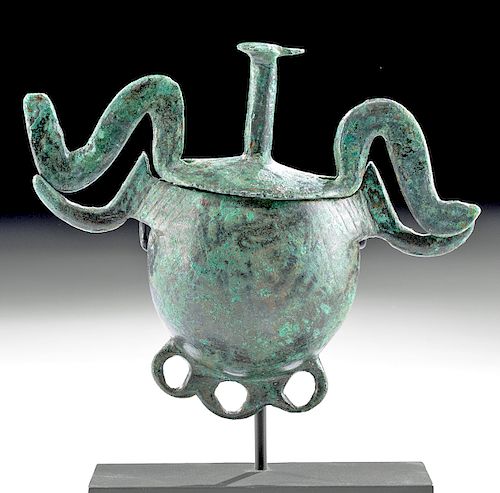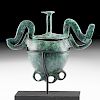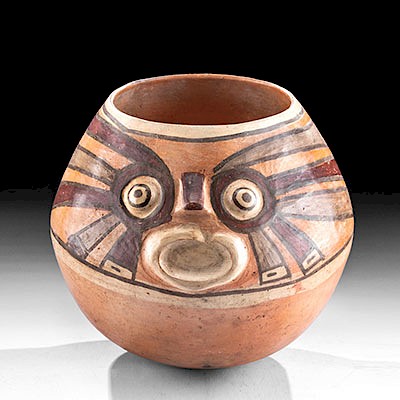Archaic Greek Bronze Lidded Pyxis w/ Bird Protomes
Lot 10
About Seller
Artemis Gallery
686 S Taylor Ave, Ste 106
Louisville, CO 80027
United States
Selling antiquities, ancient and ethnographic art online since 1993, Artemis Gallery specializes in Classical Antiquities (Egyptian, Greek, Roman, Near Eastern), Asian, Pre-Columbian, African / Tribal / Oceanographic art. Our extensive inventory includes pottery, stone, metal, wood, glass and textil...Read more
Categories
Estimate:
$800 - $1,200
Absentee vs Live bid
Two ways to bid:
- Leave a max absentee bid and the platform will bid on your behalf up to your maximum bid during the live auction.
- Bid live during the auction and your bids will be submitted real-time to the auctioneer.
Bid Increments
| Price | Bid Increment |
|---|---|
| $0 | $25 |
| $300 | $50 |
| $1,000 | $100 |
| $2,000 | $250 |
| $5,000 | $500 |
| $10,000 | $1,000 |
| $20,000 | $2,500 |
| $50,000 | $5,000 |
| $100,000 | $10,000 |
| $200,000 | $20,000 |
About Auction
By Artemis Gallery
Dec 5, 2019
Set Reminder
2019-12-05 10:00:00
2019-12-05 10:00:00
America/New_York
Bidsquare
Bidsquare : Ancient / Ethnographic - Holiday Edition
https://www.bidsquare.com/auctions/artemis-gallery/ancient-ethnographic---holiday-edition-4710
What to give this holiday season? Ancient & Ethnographic Art of course! Our special Holiday auction features hundreds of unique finds from all over the world. Artemis Gallery info@artemisgallery.com
What to give this holiday season? Ancient & Ethnographic Art of course! Our special Holiday auction features hundreds of unique finds from all over the world. Artemis Gallery info@artemisgallery.com
- Lot Description
Ancient Greece, Geometric period, ca. 8th century BCE. Skillfully cast via the lost wax (cire perdue) process, a lidded pyxis presenting an ever-so-slightly flattened globular body, a pair of wonderful bird protomes at the rim - the necks adorned by incised striations, and three conjoined rings adorning the lower end. The lid also shows bird protomes and a single vertical post/handle. This form of pyxis is called a "sickle" type, since its shape resembles that of a sickle, and was most likely used to hold perfumed oils or precious objects. Perforations just before the protomes of the lid and container were used to fasten the piece together in order to safeguard the contents and allow the pyxis to be suspended via the protruding central element with its double perforations. A wonderful example with a surface that presents lustrous, almost reflective areas as well as beautiful verdigris patina. Size: 3.5" W x 2.875" H (8.9 cm x 7.3 cm); 3.625" H (9.2 cm) on included custom stand.
Such pyxides have been found in necropoleis. Based upon the positioning of these pieces in the grave, experts believe that these pieces were suspended from the belts of the deceased. While two pyxides of a similar form were found at Samos, this type is believed to have originated in Macedonia.
Provenance: ex-Richard Wagner collection, Cape Cod, Massachusetts, 1960s
All items legal to buy/sell under U.S. Statute covering cultural patrimony Code 2600, CHAPTER 14, and are guaranteed to be as described or your money back.
A Certificate of Authenticity will accompany all winning bids.
We ship worldwide and handle all shipping in-house for your convenience.
#137123Minor nicks to peripheries and minute losses to tip of vertical post/handle. Otherwise intact and excellent with gorgeous verdigris patina.Condition
- Shipping Info
-
All shipping is handled in-house for your convenience. Your invoice from Artemis Gallery will include shipping calculation instructions. If in doubt, please inquire BEFORE bidding for estimated shipping costs for individual items.
-
- Buyer's Premium



 EUR
EUR CAD
CAD AUD
AUD GBP
GBP MXN
MXN HKD
HKD CNY
CNY MYR
MYR SEK
SEK SGD
SGD CHF
CHF THB
THB















